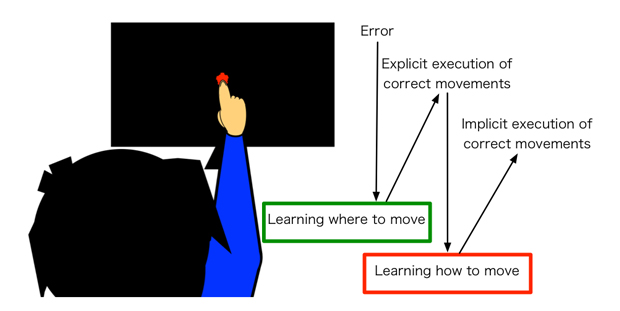
HOME > Topics2018 > 25 June 2018
25 June 2018
Takeru Honda, PhD, (Motor Disorders Project) published a paper on “Tandem Internal Models Execute Motor Learning in the Cerebellum” in PNAS.
Motor Learning for Precise Motor Execution
- Motor learning for explicit and implicit controls -
Summary
Scientists at Tokyo Metropolitan Institute of Medical Science, RIKEN, National Center of Neurology and Psychiatry, Nozomi Hospital and Tokyo Medical and Dental University have identified acquisition of two types of internal models for motor control, which are likely to be stored in the cerebellum. They show that motor control in human hand reaching movement relies on two types of motor learning: (i) acquisition of explicit motor control and (ii) acquisition of implicit motor control.
- <Title of the paper>
- Tandem Internal Models Execute Motor Learning in the Cerebellum
- <Journal>
- PNAS, July 10, 2018. 115 (28) 7428-7433; published ahead of print June 25, 2018.
https://doi.org/10.1073/pnas.1716489115
Details
It is generally accepted that precise motor control in our daily life depends on acquisition of an internal model. One motor learning for an internal model is necessary for execution of precise movements in our daily life. There are two hypothetical internal models for motor learning: where to move (i.e. calculation of destination for a given motor command) or how to move (i.e. calculation of motor command for a target). There has been long-standing controversy over “which internal model is actually working in our brain?”, for more than 30 years.
Takeru Honda, PhD, a lead author of this study, and his coauthors thought that both internal models are necessary to execute precise movement. If we learn where to move, our brain has to update the mapping from the motor command to the destination of movement. If we learn how to move, our brain has to update the mapping from the target (destination) to the proper motor command. The subjects repeatedly made a reaching movement to touch a target on a touchscreen with the index finger. Then they wore a prism glasses to have their sights shifted rightward. During initial 10 trials after wearing the prism glasses, they were not able to touch the target precisely. Instead, they touched points shifted rightward from the target. After repetitive trials, they eventually learned to touch the target precisely. In this paradigm, the authors found learning elicited by correct touching on the targets and hidden learning elicited by error between the touch position and the target position. They also provided a theory and a simple empirical formulation. Their results show that learning where to move is necessary for explicit execution of correct movements, while learning how to move is necessary for implicit execution of correct movements. Furthermore, their theory predicts that cerebellar damages induce an impairment of “where to move” or an impairment of “how to move”. Indeed, we found both types of deficits in cerebellar patients.
Therefore, the applications of this finding may help to develop clinical tests to evaluate learning capabilities of different types of cerebellar patients. The test will help to measure effects of various rehabilitations or novel therapies for cerebellar ataxia. In sports field, the present results will also help to develop effective methods of training for top athletes.
Reference figure

When subjects wore the prism glasses, they touched rightward from the targets. However, after repetitive hand-reaching movements, they learned where to move from the error between the touching point and the target’s point. As a result, they explicitly touched the targets. Note that they could not implicitly touch the targets at this stage. After repetitive explicit executions of correct movements, they implicitly touch the targets without thought.

